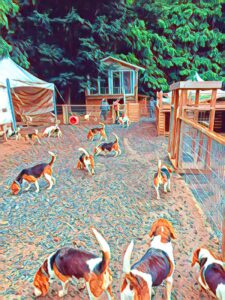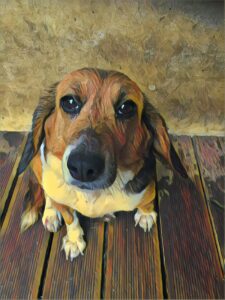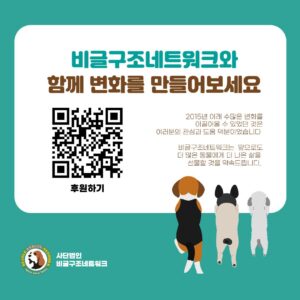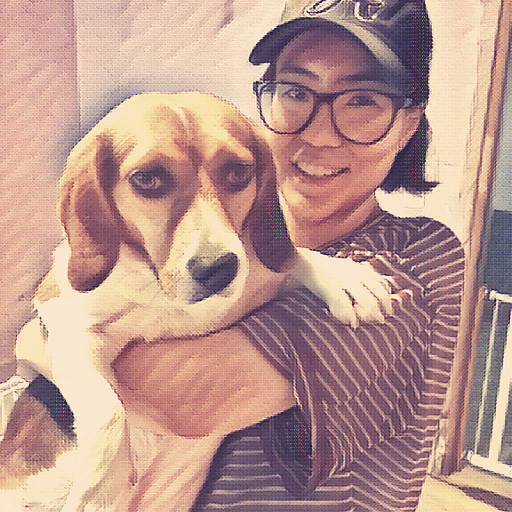A big beagly day: The story of Beagle Rescue Network Korea
A Beagle Rescue Network volunteer guides the blogger to a beagle shelter in the central part of South Korea. Many of the dogs come from laboratories.
It was beaglemania at the Beagle Rescue Network’s shelter in Nonsan, South Chungcheong Province, when I visited in July 2019 with longtime animal volunteer Jeong Buyun. A magical place full of wagging tails, inquisitive noses and muddy paws.
I took the train from Yongsan Station in Seoul early one Saturday morning, arrived at Gyeryong KTX Station around 9 o’clock, and soon found Buyun getting off the same train. A taxi took us over hilly country roads to Nonsan, about 20 minutes away, and Buyun said she hoped I wouldn’t get motion sickness.
When we arrived, dozens of friendly beagles jumped, barked and wagged their tails for attention from behind the fence. A blind beagle named Rain, a rescue from a kill pound, greeted us in the main building. The overwhelming majority of the dogs at the shelter were beagles, but there were other dogs too. The shelter had about 165 dogs, but only two full-time staff members. The organization was recruiting more workers, Buyun told me later, but it was hard to find people willing to work so far out in the country.

Among the beagles
At 26, Buyun had been active in rescue for about eight years and had three more years to go in her Ph.D. program. On average, she volunteered at the shelter twice a month. Most of the other volunteers who joined us that day were in high school or middle school, and some were there to earn school credit. Buyun led the team and showed us all what to do.
The cafeteria was in a separate building downstairs with colorful paw prints on the window alongside a cartoon beagle wishing for an end to vivisection in a thought bubble. There were brightly colored cubbyholes with extra rain boots inside, and a table displayed framed pictures of dogs who’d crossed the Rainbow Bridge.
The dogs housed in that building couldn’t live in groups. They included Samsoon and Jangsu, two pudgy beagles who’d been pulled from kill pounds within the past two or three years. They were about 10 years old.
Two volunteers joined us downstairs, and Buyun leashed some dogs for us all to walk. I got Ari, a small beagle who was stronger than she looked. We all went out to the road together and Buyun pointed to a building down the street, saying it was a dog farm and we shouldn’t walk past it. But we couldn’t avoid the nursing home next door, where two Jindo-type dogs were tied up outside and barked as we walked by.
Along the way, Samsoon slipped her collar and escaped from the volunteer behind me. I tried to catch her but there was nothing to grab onto. Thankfully, Samsoon was safely recaptured when she stopped to sniff some bushes.

Paula’s story
It didn’t take me long to fall in love with Paula.
When we were all getting ready downstairs, she was one of four dogs who were loose in the room and she looked a little scared. When she hid in a corner, I sat on a chair a few feet away. When another dog ran up to me giving kisses, Paula yelped at the other dog to scare her away. She was guarding me, like a toy or a food dish, and I was flattered.
Paula was from a laboratory, Buyun told me later, but not “the worst of the worst.” The laboratory was owned by a dog food company, and she was probably used in palatability tests.
I asked if that was why Paula was overweight, but Buyun said no.
Many of the dogs at the shelter were overweight because they had free access to dry kibble. Group housing has pros and cons, Buyun said, and one of the cons is the potential for fights over food. Free feeding reduces food aggression, but it also tends to make dogs overweight.
Near the end of the day, Paula got a bath. She was set to go to a foster home the next day.
Pepper and Mylk
It rained on and off the day I visited. When it was raining we spent some time indoors, unpacking and preparing dog treats with the student volunteers. Two other dogs got baths: a spitz named Mylk and a little silver dog named Pepper who sort of looked like a schnoodle.
Pepper and Mylk were from a puppy mill, Buyun told me. The organization’s representatives had gone there to rescue some beagles, but they couldn’t leave Pepper and Mylk behind.
Mylk’s coat still had dark scaly patches because she had mites when she first came in. The mites were gone, but it would take time for all the fur to grow back. Pepper probably had an allergy, Buyun said, because her fur was so thin that she was prone to sunburn.
Mylk was a little scared, but she cooperated when I gave her a bath and again when Buyun and the other volunteers dried her. Pepper was happy and excitable, perpetually jumping up and wagging her tail, but she also had a habit of spinning in circles. Had she picked up that behavior at the puppy mill? Buyun said she didn’t know.
Innocent victims
When the sun was shining, I helped clean up the yard: Buyun gave me a big red pooper scooper and a metal tool to scrape dog poo off the ground. Parts of the ground were rocky, and the poo was mushy, so when I picked it up I got a lot of rocks too. I must have gone through three or four scoops, and it was awkward asking for new ones. Many dogs jumped up to give kisses while I was working.
When the outer part of the yard was done, it was time to clean a smaller fenced-in area. There was a small house in this section that was equipped with electricity and heating in winter, and it was a lot nicer than what I’d seen at other shelters. A camera-shy beagle greeted me on the wooden porch outside.
Buyun came in to clean the beagle house with me, and she told me the dogs there had come from a vet school. They must have been used to practice minor procedures such as drawing blood and giving shots, she said.
At least the school turned them over to the Beagle Rescue Network instead of killing them as nearly all other vet schools do, she said as we were cleaning.
I said I thought it would be better if vet schools could open free clinics and help animals from the community — animals who really needed shots or blood tests. Buyun said she knew of only one such clinic in Korea. At most vet schools, animals don’t leave labs alive. Some vet students want to change things, she said, but their professors still cling to the old way of thinking.
None of the dogs had been used for surgical practice, Buyun told me when I asked. The school must have used other dogs for that purpose and killed them instead of releasing them for adoption, I speculated. Buyun agreed that was probably the case.
Amber
A wooden deck on the property served as a play area where the dogs could run around. In the morning Buyun and I went there with three dogs and two student volunteers. Two of the dogs were new and didn’t have names yet. The other, an affectionate girl named Amber, didn’t look much like a beagle, but Buyun told me her mom was a beagle who’d had puppies in a kill pound and then died of unknown causes.
“Her mother gave birth to five dogs in May 2017 if I remember it correctly,” Buyun wrote when I asked later. “Two of them got adopted through the pound and we took three. One got adopted and Amber and her brother Alfie are left.”
Amber was wearing a funnel collar, but she was running so fast on three legs that I didn’t notice one leg was bothering her. It was getting better slowly, Buyun said.
Sojungi
Toward the end of the day, the student volunteers went home but Buyun and I stayed longer because of the KTX train schedule. She showed me a second group of beagles from the vet school, and we gave them treats in the rainy weather. They were all wonderful dogs, but Sojungi was unforgettable.
Most of the dogs took their treats enthusiastically, and one even grabbed a treat out of my hand with his teeth. But Sojungi didn’t want treats, just attention. Later, she followed us to the gate and begged us to take her with us when we left.

Update: June 2022
Buyun, now 29 and the Beagle Rescue Network’s director of operations, is still a full-time doctoral student. She can’t attend the shelter physically because of school commitments, but she works for the charity part-time and serves on its board of directors. All the dogs I met three years ago have been adopted — some within Korea, but most to the United States.
Adoption rates within Korea are low, she explained in a Zoom interview in June.
“And the beagles, they are considered big in Korean standards. So they hardly get adopted here. So instead of keeping them at the shelter for many years, we prefer flying them to the States.”
To place dogs overseas, the Beagle Rescue Network works with two US-based beagle rescues — the California-based Beagle Freedom Project for laboratory beagles, and another rescue for the ones it pulls from pounds.
The charity now has another shelter in Boeun, North Chungcheong Province, which mostly houses dogs of other breeds, while the Nonsan shelter is still dedicated to beagles. In 2019 the Beagle Rescue Network rescued more than 1,500 dogs from a bad shelter called Aerinwon in Pocheon, Gyeonggi Province, taking over the facility after working for more than two years to shut it down. The Pocheon shelter was set to close in June 2022, two days after I spoke with Buyun.
After adopting out about half of the Aerinwon dogs, the Beagle Rescue Group still had more than 800 dogs in its care as of June 2022.
“So it’s been very challenging for us to afford their vet bills and running shelters,” Buyun said. “So we were not that actively involved with new rescue work, but still … we still have rescued laboratory beagles, because we are the only rescue in Korea who can take them. … We actually rescued 26 beagles in April of this year. And there’s another group of 18 beagles coming this week.”
Five of the 26 beagles came from a veterinary school in Korea, the other 21 from a private company.
“I can’t give you the name, but it’s one of the major chemical company in South Korea,” said Buyun. Two years ago, the same company sent 29 beagles to the charity for adoption. “So I think it was a good experience for them too, so they decided to adopt out again this year.”
Working with that company was a milestone, she said, “because that never happened before. Because those big companies, they, like, they usually don’t adopt out their animals, because it’s more — it’s easier for them to just euthanize them, because it’s easier and quicker way to just get rid of them. But somehow they wanted to, like, adopt them out. And it worked. It worked well. So they are changing, so I think it’s a good sign.”
I asked what kinds of experiments the beagles had endured, but she said the company hadn’t provided that information. Many of the dogs had torn ligaments in their hind legs requiring surgery, but otherwise they were healthy.
Asked if she had any happy stories to share, she told me about Atom. The mixed-breed dog was chained in front of a shipping container where his guardian lived, and he suffered terrible burns when the container caught fire. His guardian died, and firefighters sent Atom to a kill pound where he didn’t get prompt vet care.
“So we rescued the dog from the pound and it took several months to treat the burns,” Buyun said. After the treatment, he was still disfigured. “So we thought he would never get adopted, but he found a great home here in Korea and got adopted recently, so it’s a great joy.”
Ending vivisection
Buyun and the Beagle Rescue Network wanted to end vivisection, she confirmed when I asked in 2019, and opposed the practice on moral grounds. But their approach was a lot less aggressive than I’d hoped. For the time being, she said, the goals were to save as many beagles as possible and force vivisectors to follow existing laws — for example, to obtain animals from registered suppliers — because doing so costs more and can mean fewer animals used. That strategy was more realistic than calling for an immediate end to the use of animals in laboratories, she said.
As of June 2022, the Beagle Rescue Network still isn’t amping up the pressure. “Still, we’re not like, ‘All kinds of animal testing should be ended right away,’ but still we think that being in compliance with current law is more important at the current stage, because we don’t have that many, like, alternatives, for animal testing right now, so … Even us, we don’t know what to do if there’s no — if testing is banned, so we cannot, like, present any kind of solution to those companies or researchers. So … at the current stage, we think it’s better to go, like, less aggressive with them. We want them to follow the current law first.”

CARE vs. Beagle Rescue Network
Before I joined Buyun at the shelter that day in 2019, we’d already discussed a controversy that was in the news. The Korean animal charity CARE, or Coexistence of Animals on Earth, wasn’t sticking to its professed no-kill policy and had killed animals secretly, she’d told me — not because of end-stage terminal illness but because there was no room at its shelters. Later, citing KakaoTalk messages that were leaked to the public, Buyun says CARE killed dogs because of skin problems and pregnancy.
Under Korea’s Animal Protection Act, animals can’t be killed without a justifiable reason. Municipal pounds fall under an exception within the law, but it’s not clear whether that exception applies to CARE as a private charity.
At the time of my trip to Nonsan, there was a police investigation into alleged Animal Protection Act violations by CARE, as well as alleged financial crimes and violations of a real estate registration law. The Beagle Rescue Network had spearheaded the police complaint and publicized the case.
When the story first came out, CARE’s then-President Park So-youn denied committing any crime. Since then, she’s stepped down as president and the prosecution ultimately decided not to pursue charges concerning finances or real estate transactions. But as of June 2022, Buyun said, the investigation was ongoing in relation to the most serious of the allegations — unlawfully killing animals.
“That one was our main goal. We aimed for that, and it’s still ongoing.”
When asked what animal advocates could learn from the case, she said, “The killing, I mean, euthanasia, itself is not a problem because if the animal is suffering, sometimes euthanasia could be a last resort for them. Everyone agrees with that. But the fundamental problem with CARE issue was that they hid it from the public, and they lied. And they, like, they decided it based on their own opinion, not veterinarians’ opinion. … It was like, um, this dog has skin infection, just kill it … and that’s absolutely not right.”
CARE’s side
In a 2018 interview for The Korea Herald, AJ Garcia of CARE assured me that the charity had a no-kill policy — meaning it rejected convenience killing and accepted euthanasia only on serious medical grounds. But after the controversy came out in 2019, he never responded to any of my messages.
But in January 2020 CARE issued a statement in English, saying, “CARE President So-youn Park has been declared not guilty of all charges of embezzlement, fraud, and abuse of donations.” (By “declared not guilty,” CARE meant the prosecution had decided not to lay charges.)
In the same statement, CARE acknowledged that its president would stand trial for alleged violations of Korea’s Animal Protection Act. While not denying that CARE had killed dogs, it denied wrongdoing: “CARE, while not a shelter commissioned by a regional authority, actually followed much stricter guidelines when deciding which animals to euthanize, meaning CARE tried to save as many animals as possible.” It went on to say that Korean society should have a public debate on the subject.
Recommended reading
Buyun couldn’t think of any good resources when I asked, so here are a few of my favorites.
On homeless animals and our collective responsibility to save them: Anything by Nathan Winograd. His first book, “Redemption: The Myth of Pet Overpopulation and the No-Kill Revolution in America (2007),” is a good start.
On animal rights and vivisection: “The Case for Animal Rights” (1983) by the late philosophy scholar Tom Regan. It’s dense reading, but indispensable for anyone with a serious interest in justice for other animals.
On animal rights generally: “Speciesism” (2004) by Joan Dunayer. In accordance with her recommendations, I’m using the word “vivisection” in this article instead of euphemistic terms that minimize its horrors.
Help beagles in Korea
To inquire about volunteering, fostering or adoption, email the Beagle Rescue Network at service@beaglerescuenetwork.org. To learn more, visit the group’s website (Korean only). To donate, scan the code shown in the image or use the account below.

Nonghyup bank 355-0056-3278-23
Recipient: 사단법인 비글구조네트워크
Note
An earlier version of this blog post was published in 2019. It has been refreshed and updated for June 2022.

2 Comments